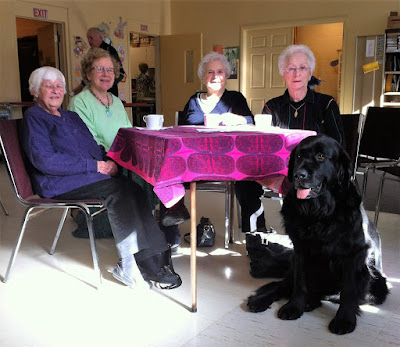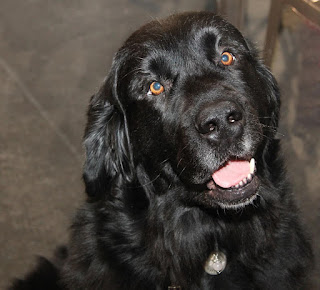**** Below are the steps we take to treat dogs who have skin issues and enter our foster program. You should always contact your veterinarian before beginning any treatment protocol -- hopefully this list of treatment options will help you and your vet come up with an effective treatment plan to help with your Newf's skin issues.****
Skin issues are becoming a common ailment in Newfs and are a condition that we frequently deal with in rescue. There are a number of things that can contribute to skin and ear issues, including allergies, genetic predisposition, thyroid dysfunction, and improper grooming and parasite prevention.
We are often contacted by desperate owners looking for help to resolve their Newf's skin issues. Depending on the severity of the issue there are a number of things that we do to help heal the dog's skin. It is important to determine what is causing the skin issue and take steps to prevent future flare-ups, not to just treat the symptoms.
Below we have listed the steps we take when a Newf who has severe skin issues arrives in our care. The first two are done immediately, then based on the condition of the dog we move onto the next steps. If you are battling chronic skin issues the first 4 items should be done right away.
1. Treat for fleas/lice/parasites -
flea bite dermatitis is a common cause of itchy, inflamed skin which then becomes infected because the dog scratches and chews. Ensure that your Newf and your home is free of fleas.
Your vet should also do a skin scraping to test for mange if that is the suspected underlying cause.
 |
| Hair loss and sores from flea bite dermatitis, Mackenzie began to heal immediately once her flea infestation was treated |
2. Diet -- when dogs arrive in our care we switch them over to a grain-free fish based food immediately. Typically we use Acana Pacifica or Orijen 6 Fish and in a very short time we often see great improvement to skin issues with this one simple change.
 |
| Hair loss due to diet. Harold began to improve immediately and began to heal when switched to Acana Pacifica. |
3. Ear and skin cultures -
by doing a culture this will let you know if any yeast or bacteria are
growing on the skin or in the ears. Unfortunately some vets will
prescribe antibiotics without doing a culture and sensitivity test
which could lead to the wrong antibiotic being used. It is important to
know if it is yeast vs bacteria as the conventional and holistic
treatments will be different.
A great product for cleaning ears is
Burow's Solution which you should be able to purchase through your vet
clinic. It is not a drug so doesn't interact with other meds. We use it
twice daily on dogs that have severe ear issues - 1 squeeze of the
bottle in the ear, rub for a minute and then wipe away any excess from
the outside of the ear. Once the ears start to clear then we will go to
once a day and then slowly back off to the point that we are only applying
it weekly for maintenance. It can also be used as a topical ointment
for really bad skin issues. We also clean the inside of the ears twice a
day at the beginning as well
using the Burow's on a cotton pad and slowly decrease as the ears clear
up.
 |
| Chronic, severe antibiotic resistant ear infections. A culture of the ear showed which antibiotics this infection was resistant to and helped us select the most appropriate treatment option |
4.
Thyroid panel - many dogs who have skin problems are also hypothyroid which is one of the
underlying causes for the skin not being healthy. A thyroid panel will
tell you if the thyroid is working correctly and if it isn't then your
dog needs to be placed on thyroid meds which will continue for the rest
of your dog's life. The meds are inexpensive and make a huge difference in the
condition
of their skin, energy levels and weight control. One thing to keep in
mind though is that even if the results are within the "normal" ranges
for the lab that does the testing a low-normal result should be treated
as a hypothyroid case. Example - Lab T4 normal range is 10-60 and the
test result is 17 - this is low-normal. The dog should be in the
mid-range, around 35-40. You have the option of having your vet draw
blood and sending a vial of serum into
Hemopet in the US. Dr. Dodds
provides specific results based on age, sex and breed and will advise
you of the dosage that should be used if the your dog is outside of the
appropriate range.
 |
| Skin issues caused by poor grooming, thyroid dysfunction and allergies |
5.
Allergy/Sensitivity testing - Blood testing is used by most allergy
vets to determine what proteins or environmental allergens are causing
an issue for the dog. The challenge with the blood test is that the dog
must be off steroids for 6 weeks. The other option for testing which is
one we have used is
Nutriscan which is a saliva based test kit that you
can do at home and then mail off to Hemopet for analysis. It isn't cheap
to purchase BUT it is cheaper than the blood tests! Environmental
allergens are tough to deal with so even if you know what your dog is
allergic to you would have a hard time controlling it. This is the
reason why we don't feel the need to do the blood testing. With Nutriscan
you will find out what proteins/grains/starches are an issue for your
dog and allows you to tailor their diet. It may lead to you needing to
move to a different kibble or it may mean changing to a RAW diet so that
you can 100% control the ingredients of your dog's diet.
6.
Bathing - We have played around with a ton of different shampoos and the
one that we are really happy with is
Eqyss Micro-Tek. You can use it at
full strength or cut it down with some water to make the bottle last
longer. Our preference is full strength while the dog is having major
issues and then as the skin is healing you can put the shampoo in a
groomers bottle so that you can add water to it. A little goes a long way
even at full strength. Dogs with severe issues should be bathed 2-3 times a week to start
with and then slowly reducing the number of baths as the skin improves.
Another shampoo that works well is
ProHex. We have used this with great success with several fosters who have serious skin issues, including Kera featured below.
 |
| Bathing and topical treatment made a huge difference for Kera |
7.
Drying - It is really important that after bathing your dog gets dried
really well. If you do not have a dog blower already we highly recommend
you look at buying one. Keeping your dog dry after bathing and swimming will
be key to long term skin health. There are many blowers on the market to
choose from but keep in mind the more powerful the blower the shorter
the drying time - unfortunately the more powerful also means more $$$.
The good news is that if you buy a high quality blower it should last
you a lifetime.
 |
| Hair loss due to lack of grooming and living in unsanitary conditions |
8. In between baths - Green tea works great for cleansing and
cooling really bad areas of the skin in between baths. Take 5 tea
bags, place them in a 4 cup bowl and add boiling water. Let the tea
steep for 10 minutes and then place it in the fridge to keep it cool. Use a clean cloth to dip into the bowl and then wipe down the bad areas
of skin multiple times a day. The other option which can be
alternated with the green tea is Povodine Iodine Solution which is
available over the counter at your local drug store. Squirt some into a
bowl and add water until it is the colour if ice tea. Wipe the skin with
a clean cloth - no need to rinse off.
 |
| Fiona required antibiotics, daily bathing and topical treatment between baths to clear her skin issues |
9. Supplements - Skin health starts from
within the body so adding supplements into your Newf's diet may help. Supplements can be purchased either online or through your local organic
health food store or health pharmacy. Below is a list
of things we use for dogs that do not respond to diet changes and
bathing:
Supplements given away from food
Dr.
Ohhira's Probiotic (or another high quality one) – 1 capsule
twice daily on an empty stomach (preferably at least 30 minutes before
food and
a minimum of 30 minutes after thyroid pills for best results).
Supplements given with food
Digestive Enzymes – 1 capsule
twice daily – open and sprinkle on food or given by mouth just before feeding
Synergy – 2 capsules twice daily –
open and sprinkle on food
Golden Paste
- start with ¼ tsp twice daily and work up to 1 tsp twice daily on food
Oil of Oregano – start with ¼ dropper
twice daily and work up to 1 dropper full twice daily on food – Either mix with
the golden paste above or put the oil directly into your Newf's mouth right before it
eats.
Kelp & Alfalfa mixed 50/50 –
start with sprinkle and work up to 1 tsp per day – sprinkled on food
Spirulina – start with a sprinkle
and work up to ½ tsp per day – sprinkled on food along with the Kelp mixture
above
Allimax – 1 capsule once per day –
open and sprinkle on food or given by mouth after feeding
Omega
Fatty Acids – minimum 2500mg
combined of DHA/EPA once per day - start at a 1/4 dose and work up over a
couple of weeks to prevent loose stool. This needs to be a fish or
krill oil based and not synthetic.
NutraSea Concentrated gel caps are a good brand. Gel caps are better than the liquid if
your can get your dog to take them because they are less likely to go
rancid.
Hopefully the information above will help get your Newf on the road to good skin health.
 |
| Luna was suffering from flea bite dermatitis and food allergies, a very simple fix |
























































